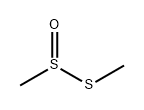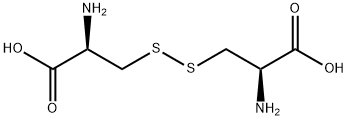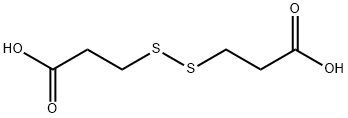Dimethyl Disulfide , >98.0%(GC) , 624-92-0
Synonym(s):
Dimethyl disulfide;DMDS;FAS;Methyl disulfide;YWHAZ
CAS NO.:624-92-0
Empirical Formula: C2H6S2
Molecular Weight: 94.2
MDL number: MFCD00008561
EINECS: 210-871-0
PRODUCT Properties
| Melting point: | -85 °C |
| Boiling point: | 109 °C(lit.) |
| Density | 1.0625 |
| vapor density | 3.24 (vs air) |
| vapor pressure | 22 mm Hg ( 20 °C) |
| FEMA | 3536 | DIMETHYL DISULFIDE |
| refractive index | n |
| Flash point: | 76 °F |
| storage temp. | Flammables area |
| solubility | 2.7g/l |
| form | Liquid |
| Specific Gravity | 1.0647 (20/4℃) |
| color | Clear yellow |
| Odor | at 0.10 % in propylene glycol. sulfurous vegetable cabbage onion |
| Odor Type | sulfurous |
| biological source | rabbit |
| Odor Threshold | 0.0022ppm |
| explosive limit | 1.1-16.1%(V) |
| Water Solubility | <0.1 g/100 mL at 20 ºC |
| JECFA Number | 564 |
| BRN | 1730824 |
| Dielectric constant | 9.7699999999999996 |
| Exposure limits | ACGIH: TWA 0.5 ppm (Skin) |
| Stability: | Stable. Incompatible with strong bases, strong oxidizing agents, strong reducing agents. Flammable. |
| InChIKey | WQOXQRCZOLPYPM-UHFFFAOYSA-N |
| LogP | 1.91 at 20℃ |
| CAS DataBase Reference | 624-92-0(CAS DataBase Reference) |
| NIST Chemistry Reference | Disulfide, dimethyl(624-92-0) |
| EPA Substance Registry System | Methyl disulfide (624-92-0) |
Description and Uses
Dimethyl disulfide has a diffuse intense onion odor. It is nonlachrymatory. Ironically, although many find its odor objectionable at high concentrations as noted above, when diluted, its aroma has also been described as pleasant. Dimethyl disulfide is often used in combination with other flavor compounds in food products, including baked goods, cheese, frozen dairy products, meat products, soups, savory flavors, fruit flavors, soft candy, gelatin, puddings, and both alcoholic and nonalcoholic beverages.
Industrially, Dimethyl disulfide is also used as a sulfiding agent to catalyze reactions in oil refineries and other industries. It has a low flash point of 16 ℃ (61 °F) that presents fire hazards during refinery usage. Due to its strong odor and low flash point, Dimethyl disulfide typically requires storage under nitrogen pressure in closed containers.
Dimethyl disulfide has a sulfurous odor similar to that of garlic and decaying fish. Because of the distinctive odor of sulfur compounds, similar to DMDS, they are often added to natural gas and propane to warn of leaks and protect people. Therefore, the odor of a DMDS fumigation can be mistaken for a gas leak. DMDS has an odor threshold of approximately 7 ppb, which is about 8 times less than the health‐based level considered by the EPA to be safe (55 ppb).
Safety
| Symbol(GHS) |     GHS02,GHS06,GHS08,GHS09 |
| Signal word | Danger |
| Hazard statements | H225-H301+H331-H317-H319-H336-H370-H410 |
| Precautionary statements | P210-P273-P280-P301+P310-P303+P361+P353-P304+P340+P311 |
| Hazard Codes | F,Xn,N,T+ |
| Risk Statements | 11-20/22-36-51/53-36/37/38-26-22-36/37 |
| Safety Statements | 26-61-45-38-36/37/39-28A-16-60-57-39-29 |
| RIDADR | UN 2381 3/PG 2 |
| WGK Germany | 2 |
| RTECS | JO1927500 |
| Autoignition Temperature | 304 °C |
| TSCA | Yes |
| HazardClass | 3 |
| PackingGroup | II |
| HS Code | 29309070 |
| Hazardous Substances Data | 624-92-0(Hazardous Substances Data) |
| Toxicity | LD50 orally in Rabbit: 290 - 500 mg/kg |






